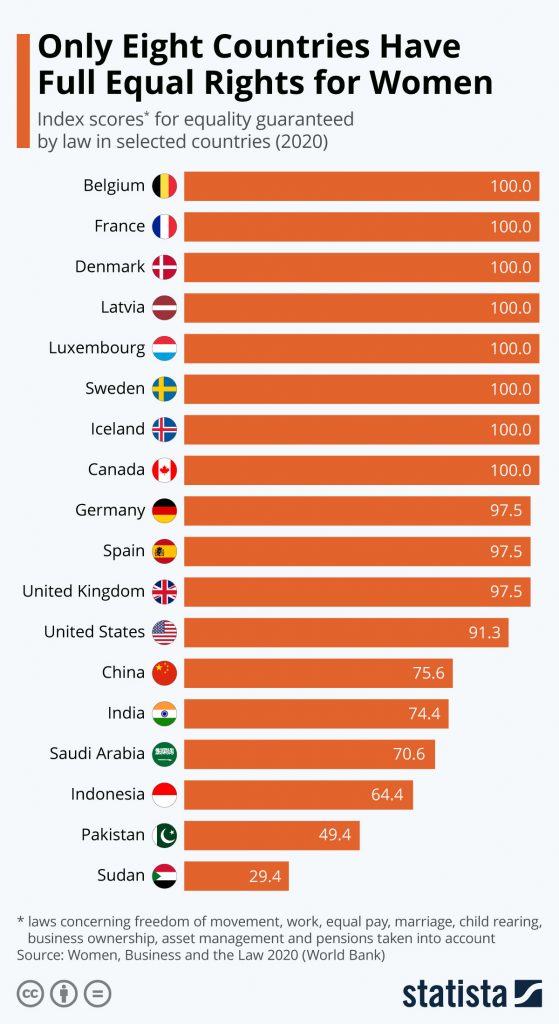Right now, there are only eight countries in the world which offer gender equality guaranteed by the law. This is according to the report from the World Bank’s project, Women, Business, and the Law 2020.
Legally equal
Belgium, France, Denmark, Latvia, Luxembourg, Sweden, Iceland, and Canada — all have obtained a perfect score of 100 in the Women, Business, and Law Index, a measure of equality of men and women in laws and regulations that hinder or facilitate a person’s economic participation.
By earning a score of 100, these eight countries possess all the laws specified by the World Bank which are deemed crucial to protect and empower women from an economic standpoint. These laws ensure that there is, legally, no gender gap.
The global average among the 190 economies included in the study is 75.2, an improvement from the 2019 average of 73.9. 87 countries in this year’s study obtained Index scores of at least 80 points.
The United States attained a fairly decent 91.3 in the Index. The US lost some points due to the lack of national laws that ensure equal pay and equal pensions.
The US is the only Organisation for Economic Co-operation and Development (OECD) country without a national statutory paid maternity, paternity, or parental leave, though it should noted that there are some states which have passed family leave laws on their own.
China, on the other hand, only gained a score of 75.6, making it an average performer in the Index.
Among the worst performers for this year are Sudan (29.4), Yemen (26.9), and West Bank and Gaza (26.3).
The most improved economy would be Saudi Arabia. Back in 2017, the country scored a measly 31.8. This year, this score inflated to 70.6. This is due to the recent comprehensive reforms which ensure the equality of men and women in aspects like mobility, workplace, marriage, parenthood, entrepreneurship, and pension.
Measuring equality in legal rights
In order to measure the magnitude of equality in legal rights between men and women, this World Bank project considered eight indicators:
- Mobility – This indicator checks for constraints in women’s agency and freedom of movement.
- Workplace – This checks the laws which might affect a woman’s decision to enter the labor market as well as protections against workplace discrimination and sexual harassment.
- Pay – This assesses the existence of a gender wage gap and laws affecting occupational segregation.
- Marriage – The right of women to be the head of the household and their rights in marriage and divorce are found to be linked with a women’s labour force participation. With this, laws covering these issues were also inspected.
- Parenthood – This checks the presence of laws that affect women’s work during and after pregnancy like paid leaves and maternity leaves, and the prohibition of the dismissal of pregnant women.
- Entrepreneurship – This indicator assesses the freedoms of women in starting and running a business.
- Assets – This examines the gender differences in property and inheritance laws.
- Pension – This indicator checks the presence of laws that eliminates potential gender gaps in pension.
According to the World Bank, these eight indicators monitor the legal differences between men and women as they transition between the different stages of working life. These eight indicators were chosen after thorough research and consultation with experts in relevant fields.
To gather information on these indicators, domestic laws and regulations of the countries included in the study were all examined.
If you want to know more about the report as well how your country performed, you can check out the full report.











